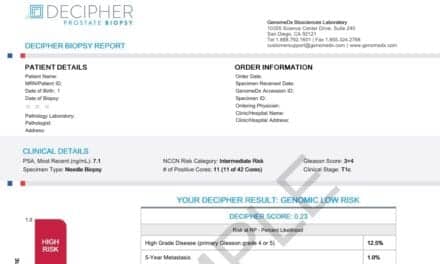Study finds molecular signature identifies which men with recurrent disease respond to apalutamide plus salvage radiation therapy.
A prospective, randomized trial has demonstrated that the PAM50 molecular signature can predict which patients with recurrent prostate cancer will benefit from hormone therapy with apalutamide in addition to salvage radiation therapy.
The findings from the BALANCE trial (NRG Oncology GU006) were presented at ASTRO 2025, the annual meeting of the American Society for Radiation Oncology, by Daniel Spratt, MD, University Hospitals Seidman Cancer Center, Case Western Reserve University. The prostate PAM50 biomarker is currently available for research use only on Veracyte’s Decipher GRID research tool.
“Our findings mark the initial time, to my knowledge, that a predictive biomarker has been validated in a prospective, biomarker-driven, randomized trial in non-metastatic prostate cancer,” says Spratt in a release. “Thus, this is an unprecedented advancement for patients who can be more precisely selected to receive hormone therapy or forego the treatment and the potential side effects.”
Study Design and Results
The study enrolled 295 men with recurrent, non-metastatic prostate cancer following prostate-removal surgery. Participants were randomly assigned to salvage radiation therapy with either a placebo or apalutamide for 6 months. The PAM50 biomarker served as a key stratification variable to ensure each treatment arm had similar proportions of luminal B and non-luminal B subtypes.
After a median follow-up of 5 years, researchers evaluated participants for biochemical failure, defined as a rise in prostate-specific antigen levels post-treatment, which serves as an early indicator of salvage therapy failure.
Among the 127 men with luminal B molecular subtype tumors, 72% of those taking apalutamide did not experience biochemical failure, compared to 54% in the placebo group (HR 0.45, 80% CI 0.29-0.68, p=0.0062). In the non-luminal B subset, there was no difference between those taking apalutamide versus placebo (70% vs 71%) (HR 0.95, 80% CI 0.65-1.41, p=0.44).
“These results from NRG GU006 represent the highest level of evidence to support routine biomarker testing in recurrent prostate cancer patients planned to receive secondary radiotherapy,” says Spratt in a release. “With such a strong difference in the metastasis-free survival response to hormone therapy between luminal B and non-luminal-B tumors, the use of the predictive PAM50 biomarker is a game changer to help personalize treatment for men with recurrent prostate cancer beyond merely prognostic tools.”
Third Predictive Biomarker for Decipher Platform
The PAM50 signature represents the third biomarker assessed through the whole-transcriptome-based Decipher platform that a major study has shown predicts benefit from hormone therapy, radiation therapy, or chemotherapy. Another trial, PREDICT-RT, recently completed enrollment two years early and is evaluating the Decipher Prostate test’s ability to predict benefit of combined hormone therapy concurrent with radiation in patients with high-risk prostate cancer at initial diagnosis.
“Prostate cancer, like all cancers, is a disease of the genome,” says Elai Davicioni, PhD, medical director for urology at Veracyte, in a release. “Our Decipher GRID tool uniquely enables researchers to better pinpoint adverse molecular features that are associated with poor outcomes. This can ultimately lead to more personalized care for each patient based on their tumor’s unique molecular make-up.”
The BALANCE trial results were among nine Decipher-focused abstracts presented at the ASTRO 2025 conference. The Decipher Prostate Genomic Classifier is a 22-gene test developed using RNA whole-transcriptome analysis and machine learning that helps inform treatment decisions across the spectrum of prostate cancer. The test’s performance and clinical utility have been demonstrated in more than 90 studies involving over 200,000 patients.
ID 158931505 © Ivan Shidlovski | Dreamstime.com





